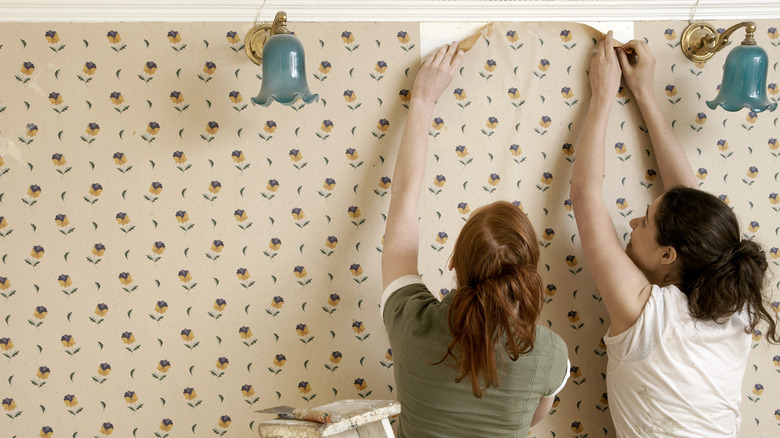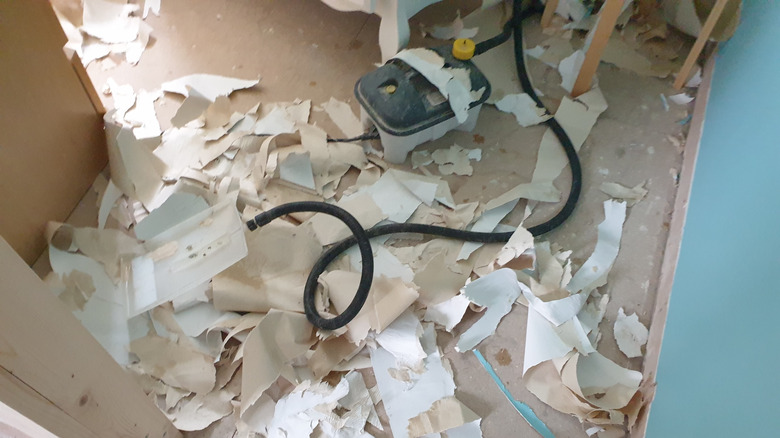The Household Staple That Will Peel That Dated Wallpaper Off With Ease
We may receive a commission on purchases made from links.
Whether you have recently moved into an older home or are finally tackling the outdated wallpaper that came with your apartment, you're probably searching for methods on how to remove the paper as efficiently and damage-free as possible. If you don't use the correct products, you can be stuck ripping off small pieces of paper one strip at a time, which will take hours, if not days. Even worse, if you use the wrong techniques, you can end up ripping off chunks of drywall along with the strips, which will force you to make difficult patching repairs. To avoid that, many people have found anecdotal success in removing wallpaper with a mixture of vinegar and hot water. That's because the hot water helps to loosen both the paper and adhesive, whereas the acid in the vinegar eats away at the glue and lifts it from the wall.
It's nothing fancy and doesn't require you to buy expensive removal tools or specialty sprays. For example, a Wallpaper Steamer Stripper can cost upwards of $60 on Amazon! Instead, you can just use a product you already have in your pantry or cleaning closet. Here is how to utilize hot water and vinegar to remove old wallpaper with ease.
How to remove wallpaper with vinegar and hot water
One of the best ways to remove wallpaper is to use hot water, vinegar, and a spray bottle. Cecil Snider, a wallpaper expert at Cecil Snider Painting Company, told Today that all you need to do is combine a 1:1 ratio of vinegar and hot water into a spray bottle. Shake the bottle to mix the two ingredients thoroughly, and then saturate a section of wallpaper with the solution. Allow it to penetrate the glue for 15 minutes, and then begin to peel off the damp strips. It's important to only saturate a section at a time so you can remove it while it's still damp and the glue has softened. You won't be able to achieve this if the paper goes back to being bone-dry.
If you run into a patch that isn't easily coming off, saturate it a little more with your vinegar solution and allow it to penetrate the glue for another 10 minutes. You don't want to tug at stubborn glue, since it will probably tear off a chunk of the drywall behind the paper. To remove the paper, Snider recommends starting from the bottom of the wall rather than the top. Use a putty knife to help you lift the paper away from the wall and gently scrape away stubborn pieces. Once all the wallpaper is off, use warm water, soap, and a soft sponge to remove any glue residue left over.
Caveats to keep in mind
Depending on how old your wallpaper is, it might be challenging to remove. They didn't have peel-and-stick technology seven decades ago, so the glue was made to keep the paper tight against the wall. Because of that, you might have some difficulty in removing them. If that's the case, try prepping the paper before you apply your vinegar liquid. You will want to use a special piercing tool called a perforator to create tiny holes in the paper, allowing the vinegar to directly slip through to the adhesive behind it. This will help it better dissolve the glue, allowing you to detach the strips more easily. If you don't know where to buy one, you can use the Rust-Oleum Zinsser PaperTiger Scoring Tool from Amazon, which clocks in at $27.
Secondly, sometimes certain wallpaper is too difficult to remove using DIY or homemade solutions. If that's the case, you might need to consider buying or renting a steamer. "If the residue is STILL being stubborn, it might be worth investing in a steamer. Older paste mixtures were designed to hold fast at pretty much any cost, so they can be a pain when it comes to wallpaper removal," Alex Whitecroft, Head of Design at I Want Wallpaper, told Homes & Gardens. "While it might be a slightly messier job, a steamer is a great way to get rid of impossibly stuck paper."

